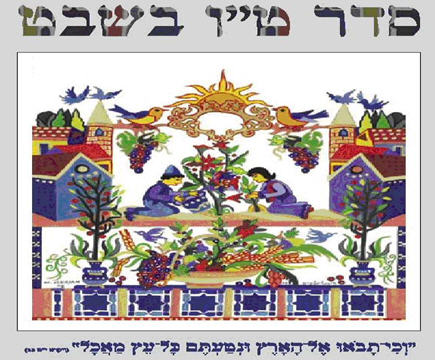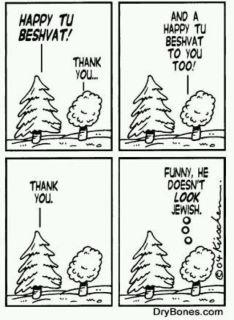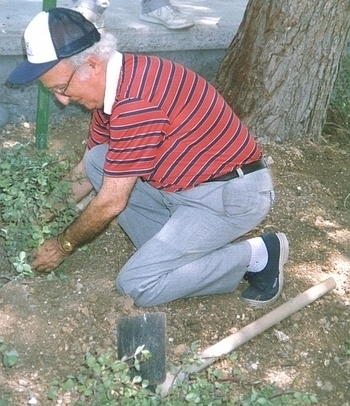Tu Bish'vat
Tu Bish'vat [the fifteenth day of the month of Sh'vat] is the Jewish Arbor Day. It marks the "New Year of the Trees" [Rosh Hashanah la'ilanot], one of the four new years of the Jewish calendar. Laws and customs connected with trees permeate the Bible and Talmud, providing an ethical basis underlying human relationships (tithing and charity) and the environment (ecology).
The importance of Tu Bish'vat in Biblical times was in calculating the beginning of the agricultural cycle for the purpose of tithes involving trees and fruit, as mandated in Vayikra [Leviticus] and Devarim [Deuteronomy]. It actually marks the day that the fruit of the tree is formed – technically, it's the day when trees are assumed to have stopped absorbing water from the ground, and instead draw nourishment from their sap. In Biblical days, it was important to know the age of the fruit tree for two reasons:
1) Orlah [new fruit]: For the first three years of a tree's production, the fruit was forbidden [literally "blocked" or "closed"]. [Leviticus - Vayikra, C.19: 23-25]. All fruit from the tree's fourth year could be eaten, but only by its owner in Jerusalem (unless it was redeemed - see Leviticus 27:34). From the fifth year onwards, the fruit could be eaten at the owner's discretion.
2) Ma'aser [tithing; literally "one tenth"]: [Deutoronomy – Dvarim, C.14: 22-29; C.26: 12]: There were two tithes on agricultural products, ma'aser rishon and ma'aser sheni, which were to be respectively set aside for the Levites and for the poor (including the stranger and the widow).
The functional reason for counting the age of the fruit trees became obsolescent when Jews were no longer living according to the agriculturally-based society of Biblical times. However, as Jews trickled back from the Diaspora, meaningful connections with the land were sought. In particular, the Sephardic mystics of Safed composed a Tu Bish'vat seder [ritual feast], based upon the Passover seder, revolving around the four worlds of the Kabbala. In 1653 the first liturgy, a collection of readings and rituals for Tu B’Shvat, was published in Salonica (Greece) under the name Pri Etz Hadar [Fruit of the Goodly/Citrus Tree].

The Tu Bish'vat Seder
Although the Tu Bish'vat seder is more flexible than the one prescribed in the Passover Haggadah, there are certain basic rituals. The meal usually consists of fruit, nuts and wine which are associated with each of the four spheres through which the sephirot [Godly emantions] flow. Together, these spheres represent the unity of the universe; as we elevate spiritually from one world to the next, we are better able to understand the unity of God. Accompanying the portions of food are reflective meditations from the Bible, Talmud and Zohar. (Steinberg)
For Atzilut, the sphere of emation of pure Godliness, the completely nonphysical aspect of the universe, white wine is drund, and no fruit is consumed. White wine also symbolizes winter.
For Briah, the world of creation, fruits that have neither a pit on the inside nor shells on the outside are chosen (grapes, figs, apples, citrons, pears, blueberries, raspberries, quinces, carobs). The second cup of wine is lightly tinted pink, symbolizing the first signs of spring and the budding of trees in Israel.
The sphere of Yetzirah, the world of formation, is signified by fruits that have a pit on the inside, but the outside of which can be eaten (olives, dates, cherries, persimmons, apricots, peaches, plums).
Assiah, the world of action, the tangible world, encompasses fruits with peel - or nuts with shells - which must be discarded, but the inside of which may be eaten (oranges, avocadoes, pomegrantes; walnuts, almonds, pine nuts, coconuts).
It is customary to eat 15 different fruit, or as many types as possible, including those fruits which a person will not have a chance to eat at other times during the year. Besides the considerations above, the fruit should represent the produce mentioned in Deutoronomy, Devarim, C.8: 7-8: "For the Lord your God is bringing you to a good land, … a land of wheat and barley, vines and figs and pomegranates, a land of oil producing olives and honey."
Besides making the appropriate blessings for wine and fruit, it is also customary to recite the fifteen Shirei Hama'alot [Psalms of Ascent] which the Levites would intone as they ascended each of the 15 steps of the Temple. Songs from the book of Shir Hashirim [Song of Songs] and popular songs in Hebrew featuring fruit and produce are also sung.
Here are four different seders to look at:
1) Kabbalistic Tu Bishvat Seder (described by Y. Buxbaum);
2) JOFA [Jewish Orthodox Feminine Alliance] seder, based on the kabbalistic tradition, and featuring special additions about Jewish women (described by Karen Stahl-Don)
3) COEJL [Coalition on the Environment and Jewish Life] seder, highlighting environmental and ecological aspects of Tu Bish'vat.
4) Seder Tikun Tu Bishvat (basically Reconstructionist and feminist – including a lot of interesting information).
For songs related to Tu Bish'vat, see the related webpage, "Tree of Life".

References
Steinberg, P. Celebrating the Jewish Year: The Winter Holidays. Jewish Publication Society, 2007.
* * * * *
The Jewish National Fund (JNF)
Say "Tu Bish'vat", and one immediately thinks of planting trees in JNF forests. Israeli children plant trees themselves; Jewish children in the Diaspora participate in the tree-planting tradition by putting weekly coins in the Blue Box ("pennies in the pushke"). Jews the world over honour people by purchasing tree certificates and planting trees in their name.

Victor Fonda, AO (1913-2012), life president of Australia JNF
The JNF is, in reality, concerned with very much more than afforestation. Founded at the Fifth Zionist Congress in Basel in 1901, it was initially set up to buy land for settlement. Since then it has been vitally involved in land reclamation, soil conservation, water management, park development, and all environmental issues. Here is a timeline summary of JNF history, followed by some videos of the work JNF is currently involved in.
♦ KKL-JNF Fulfilling Ben-Gurion's Dream To Make Israel's Desert Bloom
♦ Aleh Negev Video - A Warm Home In Israel's Negev Desert
♦ JNF Sderot Indoor Recreation Center


